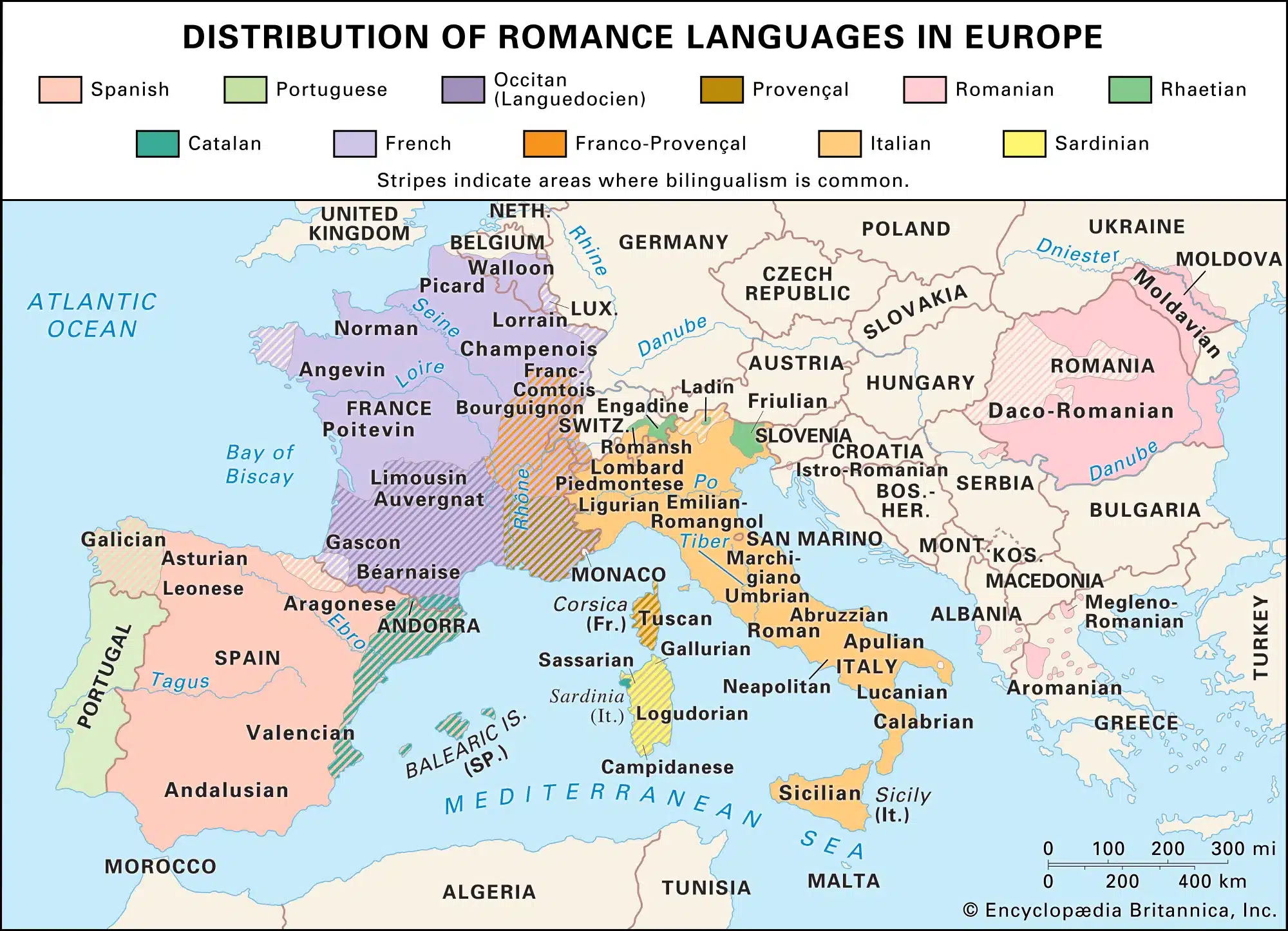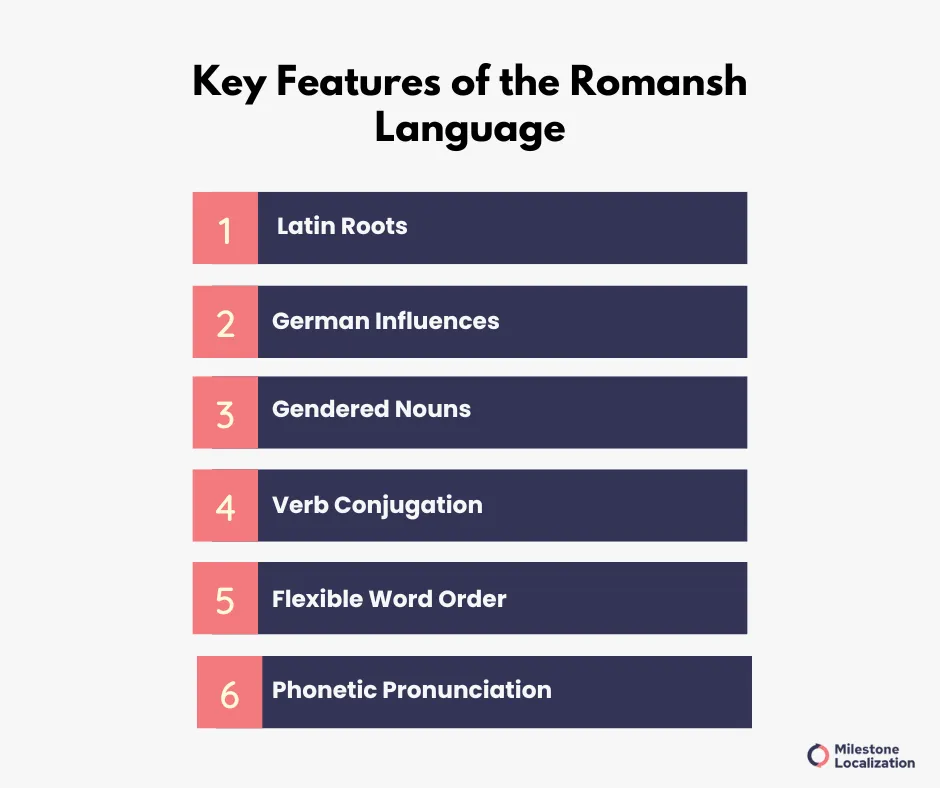Romansh is one of Switzerland’s four national languages, yet it remains unfamiliar to many outside the country. Spoken by just over 60,000 people, Romansh holds an essential place in Switzerland’s linguistic and cultural identity.
Its unique mix of Latin roots and Alpine influences makes it a linguistic treasure worth exploring. This blog delves into the fascinating history, dialects, and cultural significance of Romansh, shedding light on its key features and the ongoing efforts to preserve it.
The History and Origin of Romansh
The word Romansh (or Rumantsch, as it is spelled in the language itself) originates from the Latin word Romanicus, meaning “Roman.” It refers to the language’s roots in the Vulgar Latin spoken by the Roman settlers in the region of present-day Switzerland, particularly in the province of Raetia, after the Roman conquest in 15 BCE.
Over time, this Latin evolved into the distinct languages spoken in the area, including Romansh.
1: Medieval Evolution
By the early Middle Ages, Romansh had developed as a spoken language in the Swiss Alps, diverging from Latin while retaining its foundational structure.
2: Influence of Germanic Tribes
The migration of Germanic tribes into the region in the 5th century introduced linguistic influences that shaped the evolution of Romansh.
3: Geographic Isolation
Romansh remained a primarily spoken language in isolated Alpine valleys, allowing it to preserve its unique characteristics.
In 1938, Romansh gained official recognition as a Swiss national language. This marked a significant milestone in its history, solidifying its role in Swiss identity.

How Romansh Dialects Shape the Language’s Identity
Romansh is not a single unified language. Instead, it comprises five main dialects, each spoken in different regions of the canton of Graubünden. These dialects give Romansh its rich and diverse identity:
1: Sursilvan
It is spoken in the upper Rhine valley, it is the most widely used dialect.
2: Sutsilvan
Found in the lower Rhine valley, this dialect is less commonly spoken today.
3: Surmiran
Spoken in the Albula valley and parts of the Oberhalbstein region.
4: Putèr
Used in the Engadine valley, particularly around Zuoz.
5: Vallader
Predominantly spoken in the lower Engadine valley.

In 1982, these dialects were unified under Rumantsch Grischun, a standardized written form designed to simplify communication across Roman-speaking regions. Despite its practicality, many native speakers prefer their local dialects, preserving the linguistic diversity of Romansh.
Key Features of the Romansh Language
Romansh stands out for its distinctive mix of Latin origins and Alpine influences. Here are some of its most notable features:

1: Latin Roots
Romansh’s vocabulary is predominantly Latin-based. Words like pèrin (bread) and tschera (face) reveal its close ties to Italian, French, and Spanish.
2: German Influences
Prolonged contact with German-speaking Swiss communities has introduced German loanwords, such as banc (bench) and scola (school).
3: Gendered Nouns
Like other Romance languages, Romansh nouns have masculine and feminine forms, which influence articles and adjectives. For example, il cussegl (the advice) is masculine, while la casa (the house) is feminine.
4: Verb Conjugation
Romansh verbs follow Latin-based conjugation patterns, with distinct endings for person, number, and tense.
5: Flexible Word Order
Romansh sentences typically follow a subject-verb-object structure but allow flexibility for emphasis or poetic expression.
6: Phonetic Pronunciation
Romansh words are pronounced as they are spelled. For instance, bun di (good morning) sounds exactly as written. Romansh also reflects its geographic and cultural context, with words specific to mountain life, farming, and Alpine traditions.
Reliable Language Translation Services
Understanding the Romansh Alphabet and Script
The Romansh alphabet is based on the Latin script and consists of 23 letters. It omits “k,” “w,” and “y,” except in foreign words or names.
The alphabet’s simplicity makes it accessible, while its phonetic nature ensures that words are spoken exactly as written. This feature reduces ambiguity for learners and native speakers alike.

Also read: Latin Alphabet: Languages That Use it & Variations
A: Script Variations Across Dialects
Each Romansh dialect has its own written conventions:
1: Sursilvan
It uses diacritical marks like accents to denote stress and pronunciation, as in quél (that one).
2: Vallader
Retains many archaic spellings from older forms of the language.
3: Putèr
It shares similarities with Vallader but with subtle phonetic differences, such as chasa (house) in Putèr versus chasa in Vallader.
The creation of Rumantsch Grischun aimed to provide a unified written standard. While this standardized form is used in government documents, education, and media, native speakers often favor writing in their own dialects for personal and cultural expression.
Interesting Facts About the Romansh Language
Romansh is full of surprises. Here are some fascinating facts that showcase its unique status and cultural role
1: Switzerland’s Smallest National Language
Romansh is spoken by only 0.8% of the Swiss population, making it the least widely spoken of the four national languages.
2: Featured in Swiss Currency
Romansh text is included on Swiss banknotes alongside German, French, and Italian, reflecting its national importance.
3: Romansh in Media
RTR Radiotelevisiun Svizra Rumantscha broadcasts Romansh television and radio programs, keeping the language alive in modern formats.

4: Romansh in Pop Culture
Romansh has appeared in Swiss films and music. The popular Swiss folk band Furbaz often performs songs in Romansh, gaining national and international recognition.
5: Place Names
Many Swiss place names, like Disentis (from Mustér in Romansh), originate from the language, showcasing its historical significance.
6: UNESCO Recognition
Romansh is classified as a “vulnerable” language by UNESCO, highlighting the importance of efforts to preserve it.
Romansh and Swiss Culture
Romansh embodies the culture and traditions of the Swiss Alps. Its speakers take pride in their linguistic heritage, which is deeply intertwined with local customs.

1: Folklore and Legends
Romansh-speaking communities have a rich oral tradition of storytelling, with tales of Alpine spirits, brave villagers, and natural wonders.
2: Festivals and Celebrations
Festivals like Chalandamarz, celebrated in the Engadine valley, bring Romansh culture to life through traditional songs, dances, and parades.
3: Architecture and Lifestyle
Romansh villages feature distinct Alpine architecture, with wooden chalets, intricate carvings, and murals often inscribed with Romansh phrases.
4: Cuisine
Romansh-speaking regions boast unique dishes like capuns (Swiss chard rolls filled with meat and dough) and plain in pigna (a type of potato rösti).
Romansh is more than just a language; it is a living expression of the history, lifestyle, and environment of the Alpine regions.
Also read: Top Languages Spoken In Switzerland
Preserving and Revitalizing Romansh
Romansh faces challenges in today’s globalized world. Urbanization, migration, and the dominance of German in Switzerland threaten its survival.
However, numerous efforts are underway to preserve and revitalize this minority language:
1: Education Initiatives
Schools in Graubünden teach Romansh as a subject, ensuring that younger generations learn the language.
2: Cultural Promotion
Festivals, music, and literature celebrate Romansh traditions, keeping them alive.
3: Digital Tools
Apps like LinguaRumantscha make learning Romansh accessible to anyone interested in the language.
4: Government Support
The Swiss government allocates funding for Romansh publications, media, and cultural programs.
Community involvement also plays a critical role. Local organizations and individuals actively work to maintain Romansh’s presence in daily life.
Conclusion
Romansh is a linguistic gem that reflects Switzerland’s rich cultural and historical diversity. From its Latin origins to its Alpine dialects, Romansh offers a glimpse into a unique way of life that has endured for centuries.
Despite modern challenges, Romansh continues to thrive through education, media, and cultural initiatives. Its preservation is not just about saving a language—it’s about protecting the identity and traditions of the Romansh-speaking community.
Learning about Romansh is more than a linguistic exercise. It’s an invitation to explore the heart of Alpine Switzerland and celebrate the diversity that makes the country truly special.
Also read: Top 10 Translation Companies in Switzerland
Are You Looking for professional Translation Services?
FAQs
What is Romansh and where is it spoken?
Romansh is a Romance language spoken primarily in the canton of Graubünden in southeastern Switzerland. It is one of Switzerland’s four national languages, alongside German, French, and Italian.
How many people speak Romansh today?
Approximately 40,000–60,000 people speak Romansh as their first language. While it is considered a minority language, efforts in education, media, and cultural preservation help maintain its use.
What are the major dialects of Romansh?
Romansh has five main dialects: Sursilvan, Sutsilvan, Surmiran, Putèr, and Vallader. Each is regionally associated and varies in vocabulary, pronunciation, and spelling.
What is Rumantsch Grischun and why was it created?
Rumantsch Grischun is a standardized written form of Romansh introduced in 1982. It was developed to create a unified language for education, official documents, and media, bridging differences between dialects.
How old is the Romansh language?
Romansh traces its origins to the spoken Latin brought to the region by Roman soldiers and settlers over 2,000 years ago. Over time, it evolved alongside Alpine and local influences, creating its distinct linguistic identity.
What role does Romansh play in Swiss culture today?
Romansh is closely tied to regional identity, literature, folk traditions, and music in Graubünden. It remains an important cultural symbol and is actively promoted through schools, local media, and cultural organizations.




